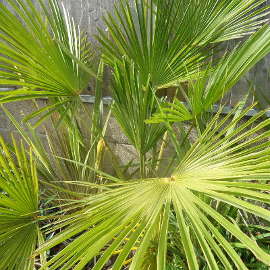

Eriobotrya japonica (Japanese Loquat or Medlar)
The Loquat is a small evergreen winter hardy tree with impressive large dark green foliage giving an almost tropical or exotic look to your garden. It produces small white flowers and fruit in some milder parts of the UK but is mainly grown for its large (8 inch long) leaves. The RHS hardiness rating is H4 which is down to -10°C so depending where you are in the UK may suffer some leaf damage in cold winters. The Loquats pictured are located in the Fens but in a city location and survived the cold temperatures of December 2010 where temperatures regularly dropped to around -6°C to -8°C during that month.

Large tropical looking foliage
The Loquat tree is not commonly grown here in the UK but it is a plant that you cannot easily mistake if you do spot one growing in someones garden. It is grown for its large long tropical looking foliage that can reach a foot long, about 30 centimetres. It is evergreen and in the UK can survive down to about -10°C (RHS say H3, -5°C) with some frost damage to any tender new growth. It will happily spring back from any damage. A sheltered shady spot will encourage larger leaves.
It makes a great small tree and tends to remain quite small and compact judging by the established specimens growing in England. In their native China and where they are commercially grown for their fruit where it is warmer they will grow to their full size, possibly up to 9 metres but about 4 or 5 metres in the UK.

May flower but doesn't often develop mature fruits
Flowers late winter to early spring but does not commonly produce flowers or fruit in many parts of the UK. They are more likely to flower and produce edible fruit in the southern parts or England or micro climates such as London.
Young plants can flower from about 3 to 5 years of age but more likely to do so after 5 years. As it flowers in the winter you will need a mild winter for the fruit to survive. The flowers and fruit can take some sub zero frosts and survive to produce fruit.

Not sure if it is the long dry summer or the fact my Eriobotrya japonica has decided to flower. Buds starting appearing in October 2018 and flowers appeared during November. It is very unlikely to produce fruit in the UK as it needs a longer warmer season but their appearance are an added late season bonus.
They appear to attract what few flying insects are still active and the fragrance is very light and delicate, I had to go right up to the flowers to smell them.
The flowers are quite small about the size of an English daisy but they appear as an inflorescence clusterted along a short stem about 4 or so inches in length.

Loquat hardiness in Britain
As previously mentioned E. japonica is hardy and evergreen when grown in this country. It can take temperatures down to about -10°C with reports from gardeners that their trees have survived periods at -15°C unscathed. Even young plants will survive outside throughout winter although they become hardier as they get bigger.

How big is Eriobotrya japonica?
This small tree can grow to 10 metres or so but is more likely to be seen in the UK at about the 5-6m mark as pictured. It makes a good specimen for even relatively small gardens and can easily be pruned to maintain a smaller size. A sheltered warm spot is ideal to give it some protection especially if you live in a rural location.

Eriobotrya japonica 'Rose Anne'

I discovered a new variety of Loquat from Colin at Swinesmeadow Farm Nursery which was originally discovered growing in a garden in Belguim.
Big Plant Nursery claims it to be hardier, more disease resistant and has larger than average leaves. All positive characteristics if you are growing exotic and tropical looking plants in the somewhat unpredictable and often damp British climate.
Eriobotrya 'Rose Anne' is a cuttining grafted onto a rootstock better suited to our climate. I have a picture here showing the foliage growing up from the rootstock which you should remove.

It's a handsome looking small tree but as yet cannot see any significant difference from the standard Loquat. The proof will be in how well it copes with any potential pests and diseases and any severe cold spells.

As for leaf size Pan Global Plants claims 'Rose Anne' leaf length to reach 30cm, as you can see from the measured leaf picture I took of a standard Loquat I have growing it measures just over 30cm in length. I am hoping for larger leaves from this new sport.

Eriobotrya deflexa 'Coppertone'
Although not grown commercially in the UK for its fruit there are a number of named cultivars grown around the world that a more prolific fruiting varieties. If you buy a UK grown specimen it will most likely be seed grown or from a cutting of a seed grown variety.
An alternative if more tender is the Coppertone or Bronze Loquat with its copper coloured new growth compared to the light green almost white of the standard variety. Think Photinia meets Loquat and you have a handsome but less hardy variety which at best may be able to take short periods of sub zero temperatures. Worth growing if you live in London or the South West but it may struggle further North.
More Evergreen Plants...
As an Amazon Associate I earn from qualifying purchases








































